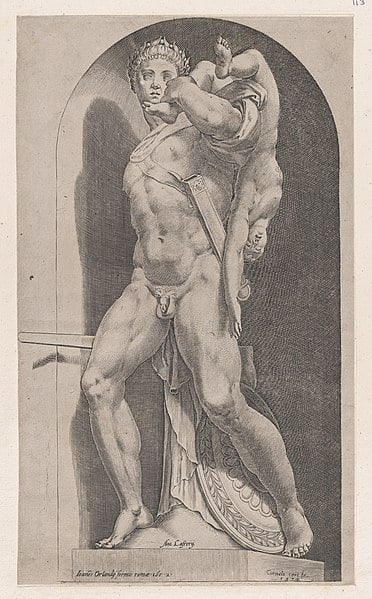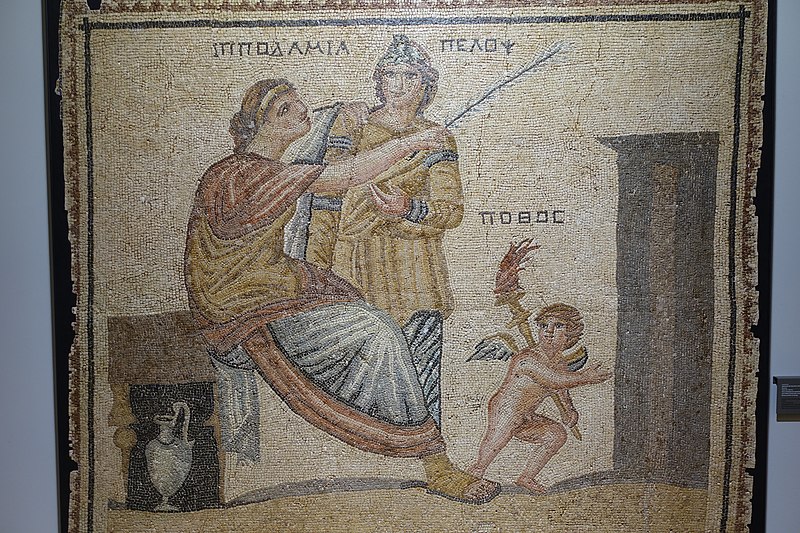In the vast tapestry of Greek mythology, Atreus stands as a figure whose tales are woven with threads of ambition, betrayal, and destiny. As we delve into the myths surrounding this legendary king, we’ll uncover the intricate relationships and events that shaped his legacy.
Atreus Key Facts
| Parents | Pelops and Hippodamia |
| Partners | Aerope |
| Siblings | Thyestes, Nicippe, and others |
| Offspring | Agamemnon, Menelaus, Anaxibia, and Pleisthenes |
| Other names | None notable |
| Roman name | Atreus |
| Best Known Myth | The Curse of the House of Atreus |
Name and Etymology
The name “Atreus” doesn’t have a clear etymology in ancient Greek, but it’s deeply rooted in the myths and legends of the time. Some scholars believe it might be derived from the Greek word “atreos,” meaning fearless. However, this is mere speculation. The Romans, ever so fond of Greek tales, didn’t alter his name, keeping it as “Atreus”. Throughout various texts and stories, he doesn’t possess many epithets or alternative names, which is rather unusual for figures of his stature in mythology.

Atreus’ Family and Relationships
Atreus, a central figure in the intricate web of Greek mythology, hailed from a lineage both blessed and cursed. Born to Pelops, The Once-eaten and Resurrected King and Hippodamia, his family’s history was marred by treachery, ambition, and divine intervention. Pelops, after being served as a meal to the gods by his father Tantalus, The Demigod Forever Thirsting for Redemption and later resurrected, was cursed, setting a dark path for his descendants.
Atreus had several siblings, but his relationship with Thyestes was the most defining and tumultuous. Their rivalry, fueled by betrayals both personal and political, would shape the destiny of Mycenae and its royal lineage. Nicippe, another sibling, is less prominent in myths but is part of the rich tapestry of the House of Pelops.
In his personal life, Atreus was wed to Aerope, and their union bore several children. Agamemnon, The Mighty King and Central Figure of the Trojan War and Menelaus, The Spartan King and Hero of the Trojan War are the most renowned, playing pivotal roles in the Trojan War and the larger narrative of Greek mythology. Agamemnon, the king of Mycenae, and Menelaus, the king of Sparta, were central figures in the war against Troy, with their actions and fates deeply influenced by their family’s curse. Anaxibia and Pleisthenes, though less frequently mentioned in myths, are also part of Atreus’ progeny.
Atreus’ life was a series of highs and lows, marked by his ascent to the throne of Mycenae and the dark deeds he committed in his rivalry with Thyestes. His relationship with Aerope was complex, characterized by love, betrayal, and political maneuvering. The discovery of her affair with Thyestes and the subsequent events, including the infamous feast where Thyestes was served his own children, showcase the depths of Atreus’ wrath and cunning.
Myths about Atreus
Greek mythology, with its intricate tales of gods, heroes, and mortals, presents Atreus as a figure whose life was a tapestry of ambition, betrayal, and destiny. His narrative, deeply interwoven with legendary events and personalities, offers a profound exploration of human nature and the inexorable pull of fate. Let’s journey deeper into the myths that define Atreus, shedding light on the events that shaped his legacy.
The Golden Lamb and the Throne of Mycenae
In the annals of Greek myths, few tales are as emblematic of betrayal and ambition as that of the golden lamb. An oracle, known for its cryptic yet unerring prophecies, declared that the one possessing a golden lamb would ascend to the throne of Mycenae. Fate seemed to favor Atreus when a lamb with a golden fleece was born amidst his flock. But destiny, ever unpredictable, took a sharp turn when Aerope, his queen, secretly handed this precious lamb to her paramour, Thyestes.
This treachery was not just a personal betrayal; it was a direct challenge to Atreus’ claim to the throne. Yet, Atreus, with a mind as sharp as the blade he wielded, devised a cunning plan. Through a blend of strategy and subterfuge, he regained possession of the lamb, thereby solidifying his rule. But this victory came at a cost. The seeds of enmity sown between the brothers would grow into a tree of vendetta, casting a long shadow over Mycenae.
The Curse of the House of Atreus
The curse that ensnared the House of Atreus is a chilling saga that traverses generations. Its origins trace back to Tantalus, Atreus’ grandfather, who, in a perverse test of the gods’ awareness, served them his son, Pelops, as a feast. The gods, repulsed and enraged by this macabre act, restored Pelops to life and condemned Tantalus to an eternity of insatiable hunger and thirst in the Underworld. This vile act birthed a curse that would persistently haunt Atreus’ lineage.
Years later, Atreus, in a fit of rage and vengeance, would amplify this curse. Upon uncovering Thyestes’ illicit liaison with Aerope, Atreus orchestrated a revenge most vile. He slaughtered Thyestes’ sons and, in a grotesque echo of Tantalus’ crime, served them to their father. This act, steeped in blood and treachery, not only intensified the ancestral curse but also paved the way for tragedies that would befall his descendants, notably Agamemnon and Menelaus.
The Banishment of Thyestes
In the aftermath of the ghastly feast and the dispute over the golden lamb, Atreus, wielding his authority as king, banished Thyestes from Mycenae. But Thyestes, burning with a desire for vengeance, sought guidance from the Delphic Oracle. The prophecy he received was as unsettling as it was clear: by fathering a child with his own daughter, he would sire the instrument of Atreus’ downfall. This prophecy birthed Aegisthus, a figure destined to play a pivotal role in the tragic fate of Atreus’ descendants, especially Agamemnon.
Atreus and the Trojan War
Though Atreus himself never set foot on the battlegrounds of Troy, his legacy was deeply intertwined with the Trojan War’s tapestry. His sons, Agamemnon and Menelaus, stood at the forefront of this legendary conflict. The abduction of Helen, Menelaus’ queen, by Paris of Troy, was the spark that ignited this monumental war.
Agamemnon, as the supreme commander of the Greek forces, grappled with dilemmas that mirrored the tragic undertones of his family’s curse. His agonizing choice to sacrifice his beloved daughter, Iphigenia, to gain favor from the goddess Artemis, and his subsequent entanglement with Briseis, a captive and a bone of contention with Achilles, resonate with the tragic decisions and repercussions that marked Atreus’ own life.
Depiction And Characteristics
Atreus, in most ancient depictions, is portrayed as a regal figure, often with a crown, symbolizing his kingship over Mycenae. He’s not associated with any specific symbols or creatures, but the golden lamb becomes emblematic of his story and the treachery that surrounds it.
His personality, as gleaned from myths, is complex. He’s ambitious and cunning, yet his actions are often driven by rage and revenge. The Ancient Greeks viewed him as a tragic figure, ensnared by the curse of his lineage and his own deeds.
Representations Of Atreus In Art
Art from ancient Greece often shied away from depicting the more gruesome aspects of Atreus’ tale. However, he’s occasionally seen in pottery and sculptures, usually in scenes involving the golden lamb or his confrontations with Thyestes. The Roman period saw a resurgence in interest in his story, leading to more artistic representations, especially in mosaic art.

Mentions in Ancient Texts
Atreus, with his tumultuous life and the profound impact he left on Greek mythology, has been referenced, directly or indirectly, in a myriad of ancient texts. These works, penned by some of the most illustrious authors of antiquity, offer insights, interpretations, and perspectives on Atreus and the curse that haunted his lineage.
“Oresteia” by Aeschylus
Written: 5th century BC
Author: Aeschylus, one of the three great tragedians of classical Athens, known for elevating the art of tragedy.
Quote: “Blood breeds blood. Death spurs on death in the race.”
The “Oresteia” trilogy delves deep into the curse of the House of Atreus, focusing primarily on his grandson, Orestes. The narrative explores themes of justice, vengeance, and the inescapable weight of familial curses.
“Iphigenia in Aulis” by Euripides
Written: Around 405 BC
Author: Euripides, another of the three great Athenian tragedians, renowned for his modern approach to traditional myths.
Quote: “The fate of life is to endure.”
This play revolves around Agamemnon’s heart-wrenching decision to sacrifice his daughter, Iphigenia, to appease the goddess Artemis. It offers a poignant exploration of duty, sacrifice, and the tragic consequences of the House of Atreus’ curse.
“Thyestes” by Seneca the Younger
Written: 1st century AD
Author: Seneca the Younger, a Roman Stoic philosopher, statesman, and dramatist known for his tragic plays and philosophical essays.
Quote: “Fate leads the willing and drags along the reluctant.”
“Thyestes” delves into the dark rivalry between Atreus and Thyestes, particularly focusing on the gruesome feast where Atreus serves his brother the flesh of his own children. The play is a testament to the depths of human depravity and the inexorable pull of destiny.
“Metamorphoses” by Ovid
Written: 8 AD
Author: Ovid, a Roman poet best known for his narrative style and his influence on later literature and art.
Quote: “Chance is always powerful. Let your hook always be cast; in the pool where you least expect it, there will be fish.”
In “Metamorphoses,” Ovid touches upon various myths, including those of the House of Atreus. While not the central focus, the references to Atreus and his lineage serve as a reminder of the tragic and intertwined fates of the characters within Greek mythology.
Frequently Asked Questions
The feud was a result of both personal betrayals, involving Aerope, and the struggle for the throne of Mycenae
A prophecy stated that the possessor of the golden lamb would rule Mycenae, leading to deceit and treachery between the brothers.
Not directly, but his sons, Agamemnon and Menelaus, were central figures in the war.
It began with Tantalus and was perpetuated by the actions of Atreus and Thyestes, leading to tragedies in their descendants’ lives.
His most notable children were Agamemnon and Menelaus, both of whom played significant roles in Greek myths.
Yes, though not as frequently as other mythological figures. He’s often associated with the golden lamb or scenes with Thyestes.
Featured Image Credit: Anonymous, Public domain, via Wikimedia Commons
